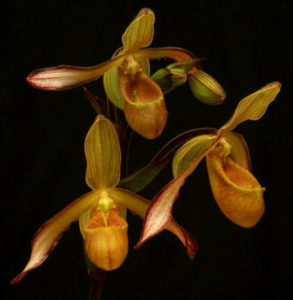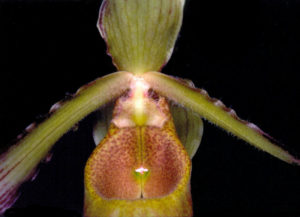The following article was written for the Orchid Species Bulletin published by the Orchid Species Society, which is based in Brisbane, Queensland in October 2002.
Bear in mind that any cultivation notes refer to the subtropical conditions of Southern Queensland, Australia.

Phragmipedium lindleyanum (Schomb. ex Lindl.) Rolfe was first collected by Richard Schomburgk in 1838. Schomburgk named it in honour of John Lindley, who described it as Cypripedium lindleyanum in Genera and Species of Orchidaceous Plants in 1840. Lindley’s description was based upon a dried herbarium specimen that Schomburgk had collected near Mt. Roraima, Guyana. Robert Rolfe transferred it to Phragmipedium in The Orchid Review in 1896.
A terrestrial plant, Phrag. lindleyanum has short clustered stems with about 5 linear-lanceolate rigid leaves that are up to 50 cm long and 6 cm broad. Tall inflorescences that are up to 1 m tall are produced from the centre of the mature growths.
The inflorescence of Phrag. lindleyanum is a simple upright raceme or it may be a shortly few-branched panicle that is green with reddish brown hairs. The 2-30 flowers are borne at the apices, opening usually one at a time and are up to 8.5 cm across. They have green or yellow-green sepals and petals. The petals have purple veins, margins and apices and the pouch-like, ochre-yellow lip is veined purple with light purple spots on the side lobes. Its staminode is yellowish.
Lucile McCook (1998) treats Phrag. sargentianum (Rolfe) Rolfe from Brazil as a synonym for Phrag. lindleyanum. When Robert Rolfe first described Phrag. sargentianum he distinguished it from Phrag. lindleyanum by the chevron-shaped white spots on the lip. These spots are not easily found on dried herbarium specimens such as the one that John Lindley used as the type for Phrag. lindleyanum. McCook says that Phrag. lindleyanum is a variable species that may have a yellowish leaf margin and flowers that vary in colour intensity and hairiness. Studies by Frank Stermitz et al. (1981) showed that Phrag. lindleyanum and Phrag. sargentianum have significantly different alkaloids, which may be grounds for keeping the two as separate taxa. Phrag. lindleyanum is found in Guyana and neighbouring Venezuela, and also in Pernambucco, Brazil.
 In Guyana, Phrag. lindleyanum grows on rocky cliffs at around 3,000 m altitude. In this habitat the plants receive full morning sun and about 60% shade for the remainder of the day. Good air circulation and frequent cool breezes keep the plants cool. Constant seepage down the granite substrate supplies regular moisture, together with dense mists in the late evening and early morning. The humus amongst which the roots grow and the constant water supply are both quite acidic. Temperatures range from 18 oC at night to 26 oC during the day.
In Guyana, Phrag. lindleyanum grows on rocky cliffs at around 3,000 m altitude. In this habitat the plants receive full morning sun and about 60% shade for the remainder of the day. Good air circulation and frequent cool breezes keep the plants cool. Constant seepage down the granite substrate supplies regular moisture, together with dense mists in the late evening and early morning. The humus amongst which the roots grow and the constant water supply are both quite acidic. Temperatures range from 18 oC at night to 26 oC during the day.
Phrag. lindleyanum seems to be easy to grow in the southeast Queensland region. Plants require bright light such as 60-70% shade and good air circulation at all times. Any well-drained potting medium is suitable and the roots should never be allowed to dry out. A shallow tray beneath the pot may help keep an adequate supply of moisture to the roots. Addition of dolomite or lime to the medium is best avoided so that the roots are kept in an acidic environment.
